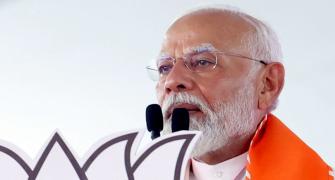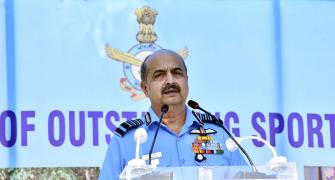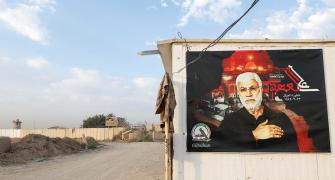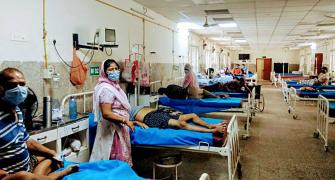The Bharatiya Janata Party has suffered defeats in 2004 and 2009 elections. The party has seen its vote share decline and its "core constituency" weaned away by its opponents. The party with a difference had commissioned a three-member team headed by Bal Apte to analyse its defeat in the 2009 polls. It was presented at the BJP's 'chintan baithak' in Shimla
This is the full report.
Analysis of Election Results
2009 Election campaign themes of the National Democratic Alliance
· Majboot Neta Nirnayak Sarkar
· India's Internal Security
· Price Rise
There is a popular perception amongst our activists and supporters that these issues either did not get positioned effectively or there was a mismatch or both to some extent.
2. Unity of Leadership
The perceived lack of unity amongst the leaders
3. Mid-campaign Distractions
Mid-campaign distractions like projection of Sri Narendra Modi as PM candidate, the Varun Gandhi controversy and reported internal squabbles within the party took centre-stage and pushed aside the main campaign issues.
4. Failure to advertise the agenda of the party
Also, we failed to highlight and bring on record the achievements of present NDA-ruled states. We also could not emphasise the effective governance of 6 years of NDA rule at centre earlier. We let the opposition get away with their single point agenda of defeating the BJP.
Media both print and visual could not be motivated to highlight the socio-economic agenda of BJP and nail the Congress for it's failure on price front, development front, internal security etc. Delay in manifesto also contributed to the same.
Important issues like 35 kg of Rs 2/- per kg rice to each Below Poverty Line family, hike in IT exemption limit, Ladli Lakshmi Yojana and other such attractive policies; could not find a place in the party's main propaganda and failed to reach the common man.
In nutshell, we failed to set an agenda of our own and let our adversaries and the biased and hostile media dictate it to us!
5. Chink in our armour-Strategy failure
Though we started very early, still our overall candidate selection process got delayed. Candidates' selection was also not appropriate at some places.
The lack of leaders of stature and profile affected our performance in certain states. (Orissa, West Bengal, Andhra Pradesh and Tamil Nadu).
Party advertisements/campaign should have been more meticulous, synchronized and made effective.
Personal attack on Manmohan Singh did not go well with people.
Mumbai vs Kandahar: We failed to corner Congress on 26/11 Mumbai attack. Instead, we let them and the media divert the issue and drag us on to Kandahar. As such, instead of discussing internal security and UPA's inefficacy in controlling terror, we ended up discussing Kandahar on every forum!
Also, our response on Kandahar was disappointing and left much to be desired. For no reason, we always appeared to be on the back foot and played defensive.
Poor alliance management -- Break up at the eleventh hour in Orissa where we were caught unawares.
In Delhi, we lost the game even before it was played out. Similarly, in Haryana, we failed to assess the popular mood and gave the Congress a virtual walk-over
In Punjab, the alliance partner's attitude has affected the NDA's performance. [The alliance management based on the past experiences has to be thoroughly discussed and a meticulous plan needs to be evolved for the future].
Almost-zero presence of the BJP/NDA in four states that account for 144 seats [Kerala, Tamil Nadu, Andhra Pradesh and West Bengal]. Congress got 103 seats from these states.
Failure to connect with the Youth?
Rajasthan and Uttarakhand-Internal squabbles, lack of unity at local level, factionalism and the BJP central leadership's failure in resolving the same in time, cost us these states eventually. Even in Delhi, lack of cohesion has affected our campaign co-ordination.
No visible enthusiasm and involvement of cadres. No proper cadre mobilization took place before elections. [Of the whole movement]
Welfare agenda of our state governments (Madhya Pradesh, Chhattisgarh, Karnataka, and Bihar] has helped us in retaining our strength in respective states.
6. External Factors
Left propping Mayawati as PM may have worked against it and in favour of Congress.
Populist Schemes of the United Progressive Alliance - NREGA and Loan Waiver - may have tilted the balance in rural India. We need to see if it really worked in favour of UPA and to what extent? Another factor could also be the announcement of high MSP [minimum support price].
7. Vote Share %:
BJP vote share as well as total number of votes was the highest in 1998. In 1999, the vote share fell marginal but that was due to the fact that BJP contested 49 seats less than in 1998, due to higher number of alliance partners. But since 1999, the party has witnessed a consistent downfall in both. In 2009, it has fallen down to the 1991 level.
The gap between the Congress and BJP that was reducing upto 1999 has started increasing since. In 2009, the gap has mounted to 9.75%. In terms of total number of votes polled too, the Congress has polled around 4 Cores more votes than that of the BJP.
8. Vote Bias
The elections in India have strangely thrown different results in different years for political parties with almost the same vote share. The following examples will prove this point:
* In 1998, the Congress polled 28.33% of votes to earn 114 seats. But in 2009, it won 206 seats with 28.55% of vote share. Although the vote share isn't the same, the number of seats went by a whooping 92.
* Trinamool Congress increased its tally by 17 seats with a mere increase of 1.13% in vote share.
* Laloo Yadav's RJD lost a meager 1.19% votes in Bihar but in terms of seats, it faced a major shock. It had lost 12 seats in 2009 as compared to 2004.
9. Anti-incumbency at the Candidate-level for BJP
In 2004, BJP fielded 156 of its 182 sitting MPs out of which 80 regained the mandate. This means 51.28% of the repeated MPs were re-elected.
In 2009, BJP fielded 71 of its 138 sitting MPs out of which 36 regained the mandate. This means 50.37% of the repeated MPs were re-elected.
The data for the two Lok Sabha elections clearly show that the anti-incumbency plays a heavy role against candidates repeated by BJP. This is irrespective of whether the party repeated 85% of its MPs or 51%; the result is the same.
Corrective action BJP needs to take:
BJP needs to introduce a performance appraisal /audit mechanism to continuously evaluate and monitor the performance of its representatives throughout the term both on the floor of the house and in the constituency.
10.BJP's downfall in SC seats
In 1996, when BJP didn't have many allies, it contested 70 of 79 SC seats and won 30. This means the strike rate of BJP in SC seats was 42%. This was more than the party's overall strike rate, which was 34%.
However in 2009, when BJP went into polls with more alliance partners as compared to 1996, it contested 63 of 83 SC seats but managed to win only 12. This means in 2009, the strike rate of BJP in SC seats was 19%. However, the party's overall strike rate in 2009 was 27%.
This is way below the party's performance in 1996. In 1996, the party's performance in SC seats was much better than its overall performance. However in 2009 the performance in SC seats was worse than its overall performance. The downfall in BJP's performance in SC seats is consistent since 2004. It is clear that the party has to think about a serious revival plan to regain the earlier held position.
11. BJP's downfall in ST seats
In 1999, BJP contested 32 of 41 ST seats and won 21. This means the strike rate of BJP in ST seats was 65.62%.
In 2004, the party again contested 32 of 41 ST seats but managed to win only 15. This means the strike rate of BJP in ST seats was 46.87%.
Now in 2009, the party contested 44 of 48 ST seats but managed to win only 15. This means the strike rate of BJP in ST seats has further come down to 34.09%.
The downfall in BJP's performance in ST seats is consistent since 2004. It is obvious that it's support amongst the ST has gone down. The party must take note of this erosion of our support base and take remedial actions or think of a serious revival plan to restore it's position.
12. Muslim factor in the polls
By and large, Indian Muslims have included Congress in its options. Various efforts from the UPA and its leadership have increased its acceptability amongst Muslims. As expected, in states where BJP was in direct fight with Congress, Muslims voted for the Congress candidates.
In states where there are more than two major players, Muslims voted for the candidate who could give the toughest fight to the BJP candidate. That means in a state like UP, Muslims chose their party/candidate at the constituency level. Therefore, whereas Muslims preferred BSP in Western Uttar Pradesh, they preferred Congress in the Central Uttar Pradesh.
In certain states, Muslim-parties which contested parliamentary elections for the first time performed well. The biggest such example is Assam where AUDF won 17% of the votes at the Cost of Congress. In Eastern Uttar Pradesh two Muslim parties - Ulema Council and Peace Party also contested elections, and polled around 10% in five constituencies. This indicates that in certain areas of the country, Muslims have started thinking in terms of promoting political parties which are led by Muslims and whose main agenda is to work for the Muslim issues. IUML has become an attractive and feasible role model for Muslims for using the democratic process for their advantage.
In Kerala, Muslims have largely supported Congress and IUML alliance. In West Bengal, Muslims have voted in favor of Trinamool - Congress front.
13. Voting Trends - Myths & Realities
That urban voters moved towards the Congress due to young leadership of Rahul is a myth.
While it did extremely well in Delhi, its performance in Mumbai was not good. Still it gained seats due to MNS cutting into Shiv Sena-BJP votes.
Congress major gain in voting percentage in urban area, was in Delhi by 2.3% compared to 2004.
Congress mainly gained from decline and division in the vote share of its opponents. The reality of Congress win: Fall in BJP votes [marginal] but more so negative swings against regional parties such as the Telugu Desam Party (8 per cent), the All India Anna Dravida Munnetra Kazhagam (7 per cent) and the Samajwadi Party (4 per cent); the emergence of new parties like the Prajarajyam Party in Andhra Pradesh; the rise of the MNS in Maharashtra.
The adverse effect of the break-up of the BJP-Biju Janata Dal alliance in Orissa.
In Uttar Pradesh, the Congress secured 21 of the 80 seats, even though it polled only 18.25 per cent of the popular vote. Last time it had polled 12.04% votes and won 9 seats.
The BJP polled 17.50% votes only -- 0.75% less than the Congress -- and won 10 seats in 2009. In 2004 it had polled 22.17% but won only 10 seats.
What helped the Congress in UP was the favourable distribution of votes -- concentrated in a few pockets -- that helped the party to translate its fewer votes into seats.
The Congress' performance was more targeted in 2004 and 2009 - more seats even with lesser number of votes.
NDA performance in States
1. NDA performance in its traditional strongholds
Out of 346 seats covering 16 states where BJP and its allies have traditionally been strong players, NDA has got 153 seats whereas UPA could get only 128 seats. 65 seats went into the kitty of other players.
|
Sl No |
States |
Total seats |
NDA |
UPA |
Other seats | ||
|
Seats |
% |
Seats |
% |
||||
|
1. |
Gujarat |
26 |
15 |
46.6 |
11 |
43.5 |
0 |
|
2. |
Rajasthan |
26 |
4 |
36.6 |
20 |
47.2 |
1 |
|
3. |
Madhya Pradesh |
29 |
16 |
43.5 |
12 |
40.1 |
1 |
|
4. |
Uttar Pradesh |
80 |
15 |
20.8 |
21 |
18.2 |
44 |
|
5. |
Bihar |
40 |
32 |
38.0 |
2 |
10.3 |
6 |
|
6. |
Maharashtra |
48 |
20 |
35.2 |
25 |
40.2 |
3 |
|
7. |
Karnataka |
28 |
19 |
41.6 |
6 |
37.7 |
3 |
|
8. |
Jharkhand |
14 |
8 |
27.5 |
1 |
15.0 |
5 |
|
9. |
Chattisgarh |
11 |
10 |
45.0 |
1 |
37.3 |
0 |
|
10. |
Uttarakhand |
5 |
0 |
34.0 |
5 |
43.3 |
0 |
|
11. |
Himachal Pradesh |
4 |
3 |
49.5 |
1 |
45.6 |
0 |
|
12. |
Goa |
2 |
1 |
44.8 |
1 |
22.6 |
0 |
|
13. |
Assam |
14 |
5 |
30.8 |
7 |
34.9 |
2 |
|
14. |
Arunachal Pradesh |
2 |
0 |
37.2 |
2 |
51.1 |
0 |
|
15. |
Punjab |
13 |
5 |
43.9 |
8 |
45.2 |
0 |
|
16. |
Delhi |
7 |
0 |
35.2 |
7 |
57.1 |
0 |
12. NDA performance in NDA Ruled States
BJP and its NDA allies has been able to retain their position of performance in NDA-ruled states except Uttarakhand and Punjab. Out of 156 Seats in eight NDA-ruled states, the alliance got 100 seats while UPA managed to get only 46 seats. The social-welfare agenda of the NDA govts has worked in favour of NDA candidates.
|
Sr No |
States |
Total seats |
NDA |
UPA |
Others |
|
1. |
Gujarat |
26 |
15 |
11 |
0 |
|
2. |
Madhya Pradesh |
29 |
16 |
12 |
1 |
|
3. |
Punjab |
13 |
5 |
8 |
0 |
|
4. |
Karnataka |
28 |
19 |
6 |
3 |
|
5. |
Bihar |
40 |
32 |
2 |
6 |
|
6. |
Chattisgarh |
11 |
10 |
1 |
0 |
|
7. |
Uttarakhand |
5 |
0 |
5 |
0 |
|
8. |
Himachal Pradesh |
4 |
3 |
1 |
0 |
|
Total |
156 |
100 |
46 |
10 |
States in which BJP and Congress were in a direct Fight
The BJP and Congress were in direct fight in 10 States in 3 Union Territories which counted for a total of 154 seats. Out of this, BJP has managed to win 79 seats whereas Congress could get 65. Other got 10.
|
Sr No |
States |
Total seats |
BJP |
Congress |
Others |
|
1. |
Gujarat |
26 |
15 |
11 |
0 |
|
2. |
Madhya Pradesh |
29 |
16 |
12 |
1 |
|
3. |
Rajasthan |
25 |
4 |
20 |
0 |
|
4. |
Himachal Pradesh |
4 |
3 |
1 |
0 |
|
5. |
Karnataka |
28 |
19 |
6 |
3 |
|
6. |
Uttarakhand |
5 |
0 |
5 |
0 |
|
7. |
Chattisgarh |
11 |
10 |
1 |
0 |
|
8. |
Jharkhand |
14 |
8 |
1 |
5 |
|
9. |
Goa |
2 |
2 |
1 |
0 |
|
10. |
Delhi |
7 |
0 |
7 |
0 |
|
Union Territories |
|||||
|
1. |
Dadra-Nagar Haveli |
1 |
1 |
0 |
0 |
|
2. |
Daman Diu |
1 |
1 |
0 |
0 |
|
3. |
Andaman |
1 |
1 |
0 |
0 |
|
Total |
154 |
79 |
65 |
10 |
NDA performance in Third Front strongholds
BJP/NDA was not serious contender in Andhra Pradesh, Tamil Nadu, Kerala and West Bengal (144) where we have won only one seat.
|
States |
Total seats |
UPA/Congress |
Left Third Front |
Others | ||
|
Won |
% |
Won |
% |
|||
|
Andhra Pradesh |
42 |
34 |
39 |
6 |
33.6 |
2 |
|
Tamil Nadu |
39 |
27 |
42.5 |
12 |
37.4 |
0 |
|
West Bengal |
42 |
26 |
44.7 |
15 |
43.4 |
1 |
|
Kerala |
20 |
16 |
47.7 |
4 |
41.9 |
0 |
|
Orissa |
21 |
6 |
32.8 |
15 |
37.2 |
0 |
|
Total |
164 |
109 |
52 |
3 | ||
The five states where Third Front parties are considered to be in the main fight with Congress account for total 165 seats. UPA/Congress has been able to garner 109 seats out of these. In fact, these five states have contributed 41% of the total 262 seats won by UPA at the national level.
The Third Front could only get 52 seats. NDA has won an insignificant 1 seat.
The performance of UPA becomes even better if we exclude Orissa. Out of 144 seats, the UPA bagged 103 seats.
People in these states might have wanted to bring a stable government at the centre that would be free from the manipulations of the small regional players. Since BJP is absent in these states, Congress became the logical beneficiary of these feelings of the people.
For example, the performance of TDP was much better in the assembly elections compared to its performance at the parliament-level.







